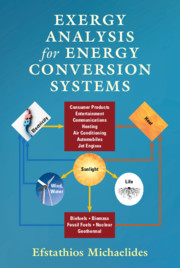Book contents
- Exergy Analysis for Energy Conversion Systems
- Exergy Analysis for Energy Conversion Systems
- Copyright page
- Dedication
- Contents
- About the Author
- Preface
- Symbols
- Abbreviations
- 1 Introduction
- 2 Exergy
- 3 Energy Conversion Systems and Processes
- 4 Exergy Consumption and Conservation
- 5 Exergy in Biological Systems
- 6 Ecosystems, the Environment, and Sustainability
- 7 Optimization and Exergoeconomics
- Index
- References
2 - Exergy
Published online by Cambridge University Press: 19 March 2021
- Exergy Analysis for Energy Conversion Systems
- Exergy Analysis for Energy Conversion Systems
- Copyright page
- Dedication
- Contents
- About the Author
- Preface
- Symbols
- Abbreviations
- 1 Introduction
- 2 Exergy
- 3 Energy Conversion Systems and Processes
- 4 Exergy Consumption and Conservation
- 5 Exergy in Biological Systems
- 6 Ecosystems, the Environment, and Sustainability
- 7 Optimization and Exergoeconomics
- Index
- References
Summary
Mechanical energy is the most useful energy form to humans. This motivates the question: given an energy resource – fossil or nuclear fuel, wind, solar, geothermal – what is the maximum mechanical energy one may extract? A similar question is: what is the difference between the low-temperature waste heat of a nuclear power plant and the high-temperature heat in the nuclear reactor? The combination of the first and second laws of thermodynamics, in conjunction with the characteristics of the environment where energy conversion processes occur, offers a definitive answer to these and similar questions: exergy is the thermodynamic variable that describes the maximum mechanical work that may be extracted from energy resources, the concept that quantifies the quality of energy. This chapter elucidates the concept of exergy and its relationship to the energy resources. It derives useful expressions for the exergy of primary energy sources including: fossil fuels, geothermal, solar, wind, hydraulic, tidal, wave, and nuclear. The effects of the environment on the exergy of energy sources, the energy conversion processes, and the exergetic efficiencies of the processes are also elucidated.
Keywords
- Type
- Chapter
- Information
- Exergy Analysis for Energy Conversion Systems , pp. 25 - 78Publisher: Cambridge University PressPrint publication year: 2021



